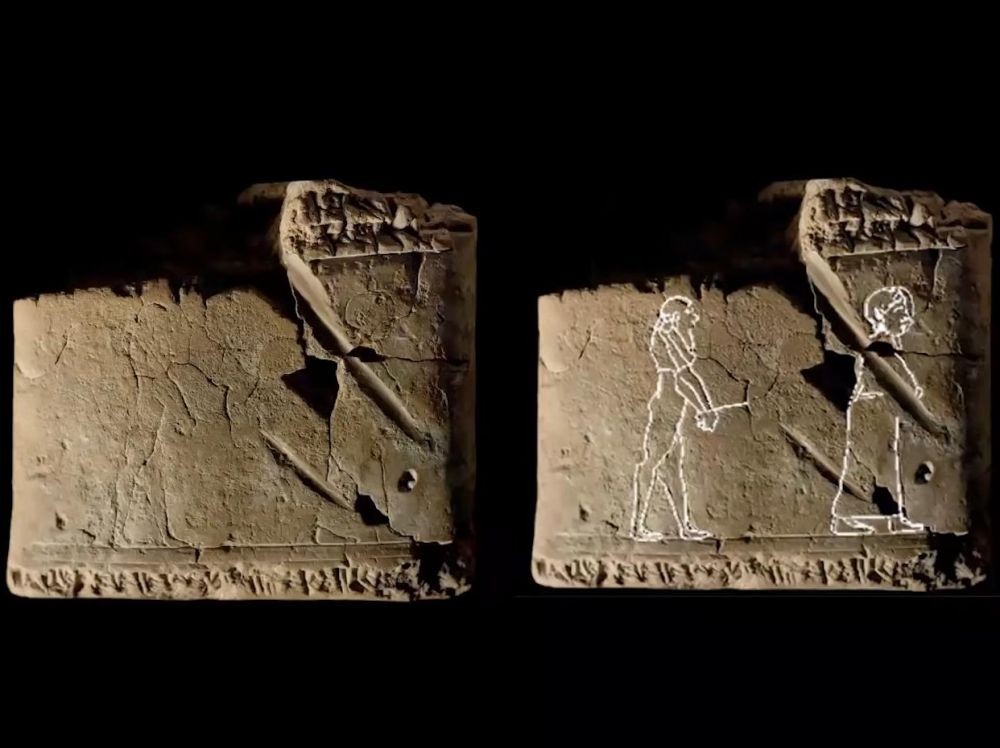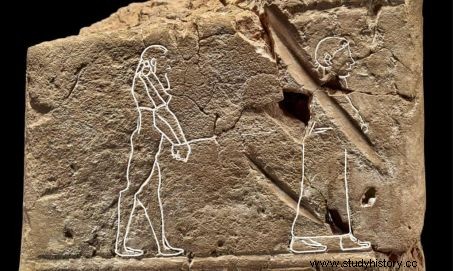Hidden on a 3,500-year-old Babylonian clay tablet, this drawing of a ghost, visible only under light and at a certain angle, had never before attracted the attention of archaeologists and other experts.

On this Babylonian clay tablet, we see a spirit being led into the afterlife by a woman. The drawing of the white line was made by Chris Cobb for the book by Irving Finkel, "The first ghosts:the oldest of legacies".
The story of its discovery itself has something fantastic, in the supernatural sense of the word. Forgotten in the dark vaulted storerooms of the British Museum, it will have waited more than a hundred years - since its acquisition in the 19th century - before someone finally notices it and does it justice. The oldest ghost drawing ever recorded has just been identified on a 3,500-year-old Babylonian clay tablet. It takes the form of a bearded man who, his fists tied, is guided by a woman, no doubt towards the afterlife.
The tablet, of which only half remains, is small enough to fit in the palm of a hand. According to the Assyriologist and curator in the Middle East department of the British Museum Irving Finkel, who discovered it in the basement of the museum, it would have been badly deciphered in the past and thus left in the archives. And for good reason:the ghost design is only visible when viewed from a certain angle - from above - and in direct light. For Irving Finkel, interviewed by the Guardian , which reveals the story, it is an “absolutely spectacular antique object” .
A lonely ghost
This tablet originally belonged to a set forming a guide for an exorcist:on the back of the fragment, instructions on what to do in the event of harassment by a ghost have been deciphered. In particular, the exorcist is advised to focus on why this soul is wandering the world of the living. In the case of our bearded ghost, it would seem that too much loneliness – in love? - explains that he comes back to haunt the living.

"It's obviously a male ghost and he's miserable. You can imagine that a tall, thin, bearded ghost hanging around the house pisses people off. ghost needed a partner" , details Irving Finkel in the columns of the British daily. The spirit is represented walking with outstretched arms, wrists tied by a rope held by a woman, the very one who will send it back to the afterlife.
Miniature reconstruction
In particular, it is advisable to make figurines of a man and a woman, like small voodoo dolls:"Dress the man in everyday clothes and weigh him down with travel supplies. Dress the woman in four red garments and drape her in purple cloth. Give her a gold brooch. E also equip it with a bed, a chair, a mat and a towel; give him a comb and a water bottle" , translated the specialist in cuneiform, the name of this writing system widespread throughout the ancient Near East and which lasted until the dawn of the Christian era.
The text continues:"At sunrise, towards the sun, begin the ritual preparations and set up two carnelian beer vessels. Lay down a special vessel and set up a juniper censer with juniper. Draw the curtain like that of the diviner. Arrange the figures with their equipment and place them in position...Finally, say as follows, Shamash [god of the sun and judge of the underworld at night]." And to conclude with a comical warning:"Don't look behind you!"
According to the expert, whose discovery is accompanied by a book to be published on November 11, 2021 by Hodder &Stoughton, "The First Ghosts:Most Ancient of Legacies" ("The First Ghosts:The Oldest of Legacies"), the tablet was probably part of an exorcist's personal library, full of magical writings. He hopes to see it displayed one day in the windows of the British, and no longer buried in its undergrounds.
